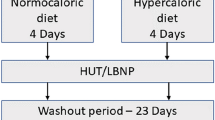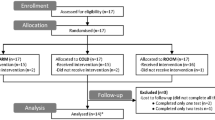Abstract
In patients with neurocardiogenic syncope, the beneficial effects of increased daily fluid intake, without an accompanying high dose of salt, are unknown. Our aim was to (1) determine whether plasma volume was low in patients with recurrent neurocardiogenic syncope, and (2) determine how recommendation about increased daily fluid intake, without an accompanying high dose of sodium, effects plasma volume and if this potential therapy improves orthostatic tolerance. Eighty-six patients with neurocardiogenic syncope were recruited in a prospective randomized open study. After an initial head-up tilt test, patients were randomly assigned to either the hydration supplementation group (1500 ml of water + 1500 mg of NaCl/day) or the no treatment (control) group. After ten days a second head-up tilt test was performed. Plasma volume, osmolality, and total body water were measured at baseline, and heart rate, arterial blood pressure, and cardiac transthoracic impedance were monitored during tilting. Hydration treatment did not affect the number of positive tilt tests (52% initial day, 54% after treatment, NS). In both groups, the overall number of positive tilt tests decreased between the initial and final head-up tilt test. There was no association between low plasma volume and positive tilt test. Patients with the lowest plasma volume were equally distributed in both positive and negative tilt response groups. An increased daily intake of fluid, without an accompanying high dose of salt, had no measurable beneficial effect on tolerance to head-up tilting in patients with neurocardiogenic syncope. Moreover in this patient group there was no association between a low plasma volume and a reduced tolerance to orthostatic stress.


Similar content being viewed by others
References
Altun B, Arici M (2006) Salt and blood pressure: time to challenge. Cardiology 105:9–16
Bellard E, Fortrat JO, Schang D, Dupuis JM, Victor J, Lefthériotis G (2003) Changes in the transthoracic impedance signal predict the outcome of a 70° head-up tilt test. Clin Sci 104:1–8
Buell JC (1998) A practical, cost effective, non invasive system for cardiac output and hemodynamic analysis. Am Heart J 116:657–664
Claydon VE, Schroeder C, Norcliffe LJ, Jordan J, Hainsworth R (2006) Water drinking improves orthostatic tolerance in patients with posturally related syncope. Clin Sci 110:343–352
Cooper VL, Hainsworth R (2002) Effects of dietary salt on orthostatic tolerance, blood pressure and baroreceptor sensitivity in patients with syncope. Clin Auton Res 12:236–241
Ector H, Reybrouck T, Heidbüchel H, Gewillig M, Van de Werf F (1998) Tilt training: A new treatment for recurrent neuro-cardiogenic syncope and severe orthostatic intolerance. Pacing Clin Electrophysiol 21:193–196
el-Sayed H, Hainsworth R (1995) Relationship between plasma volume, carotid baroreceptor sensitivity and orthostatic tolerance. Clin Sci 88:463–470
Hainsworth R (2004) Pathophysiology of syncope. Clin Auton Res 14:I/18–I/24
Haller M, Akbulut C, Brechtelsbauer H, Fett W, Briegel J, Finsterer U, Peter K (1993) Determination of plasma volume with indocyanine green in man. Life Sci 53:1597–1604
Hargreaves AD, Muir AL (1992) Lack of variation in venous tone potentiates vasovagal syncope. Br Heart J 67:486–490
Haycock GB, Schwartz GJ, Wisotsky DH (1978) Geometric method for measuring body surface area: a height-weight formula validated in infants, children, and adults. J Pediatr 93:62–66
Johansen LB, Foldager N, Stadeager C, Kristensen MS, Bie P, Warberg J, Kamegai M, Norsk P (1992) Plasma volume, fluid shifts, and renal responses in humans during 12 h of head-out water immersion. J Appl Physiol 73:539–544
Kaufmann H, Freeman R (2004) Pharmacological treatment of reflex syncope. Clin Auton Res 14:I/71–I/75
Kaufmann H, Wieling W (2004) Syncope: a clinically guided diagnostic algorithm. Clin Auton Res 14:I87–I/90
Low PA, Schondorf R, Novak V, Sandroni P, Opfer-Gehrking TL, Novak P (1997) Postural tachycardia syndrome. In: Low PA (Ed) Clinical autonomic disorders. Lippincott Raven, Philadelphia New York, pp 681–697
Ludwig DA, Convertino VA (1994) Predicting orthostatic intolerance: physics or physiology? Aviat Space Environ Med 65:404–411
Mallat Z, Vicaut E, Sangaré A, Vershueren J, Fonaine G, Frank R (1997) Prediction of head-up tilt test of early heart rate variations. Circulation 581–584
Mehlsen J, Bonde J, Stadeager C, Rehling M, Tango M, Trap-Jensen J (1991) Reliability of impedance cardiography in measuring central haemodynamics. Clin Physiol 11:579–588
Millet C, Custaud MA, Maillet A, Allevard AM, Duvareille M, Gauquelin-Koch G, Gharib C, Fortrat JO (2001) Endocrine responses to 7 days of head-down bed rest and orthostatic tests in men and women. Clin Physiol 21:172–83
Schadt JC, Ludbrook J (1991) Hemodynamic and neurohumoral responses to acute hypovolemia in conscious mammals. Am J Physiol 260:H305–H318
Schroeder C, Bush VE, Norcliffe LJ, Luft FC, Tank J, Jordan J, Hainsworth R (2002) Water drinking acutely improves orthostatic tolerance in healthy subjects. Circulation 106:2806–2811
Spodick D, Doi YL, Bishop RL, Hashimoto T (1984) Systolic time intervals reconsidered. Reevaluation of the pre-ejection period: absence of relation to heart rate. Am J Cardiol 53:1667–1670
Sutton R, Petersen M, Brignole M, Raviele A, Menozzi C, Giani P (1992) Proposed classification for tilt induced vasovagal syncope. Eur J Cardiac Pacing Electrophysiol 2:180–183
Thijs RD, Reijntjes RH, van Dijk JG (2003) Water drinking as a potential treatment for idiopathic exercise-related syncope: a case report. Clin Auton Res 13:103–105
Wieling W, Colman N, Krediet CTP, Freeman R (2004) Nonpharmacological treatment of reflex syncope. Clin Auton Res 14:I/62–I/70
Younoszai AK, Franklin WH, Chan DP, Cassidy SC, Allen HD (1998) Oral fluid therapy. A promising treatment for vasodepressor syncope. Arch Pediatr Adolesc Med 152:165–168
Acknowledgements
The authors wish to thanks the nurses from the cardiology department and Dr Yves Gallois and Cédric Ménard for their technical help in plasma volume determination. This work was funded in part by Centre Evian pour l’Eau and supported by the Direction de la Recherche Clinique of the Centre Hospitalier of Angers. This study was supported by a grant from Centre Evian pour l’Eau. The sponsor of the study had no role in the study design, data collection, analysis, interpretation or writing of the report
Author information
Authors and Affiliations
Corresponding author
Rights and permissions
About this article
Cite this article
Bellard, E., Fortrat, JO., Custaud, MA. et al. Increased hydration alone does not improve orthostatic tolerance in patients with neurocardiogenic syncope. Clin Auton Res 17, 99–105 (2007). https://doi.org/10.1007/s10286-007-0409-0
Received:
Accepted:
Published:
Issue Date:
DOI: https://doi.org/10.1007/s10286-007-0409-0




